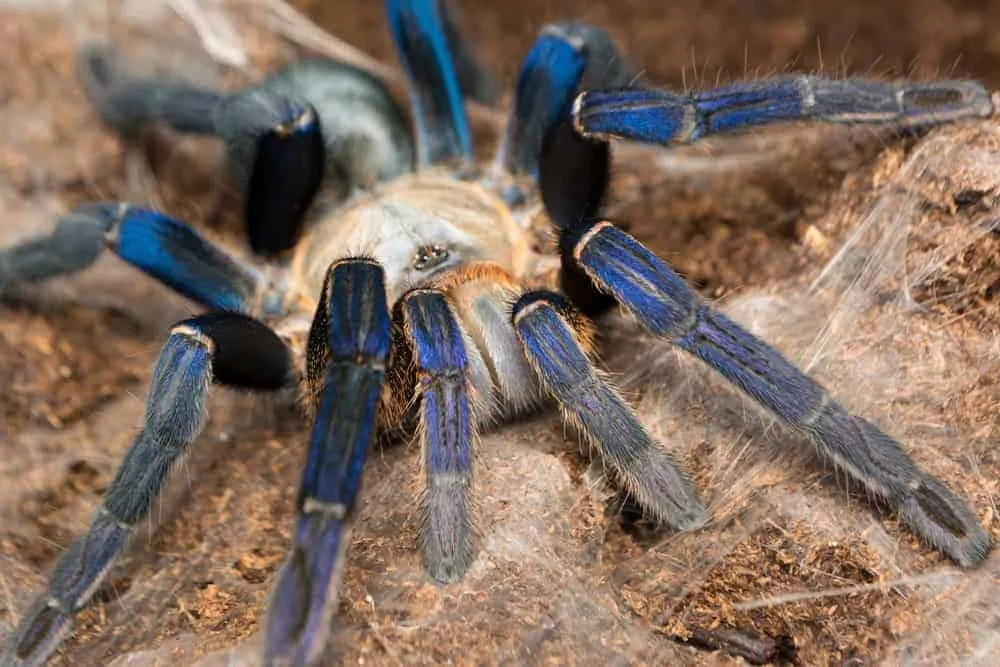Cobalt Blue Tarantula Top 5 Facts!
The Cobalt Blue Tarantula, scientifically known as Cyriopagopus lividus, is a striking species that captivates enthusiasts with its vibrant coloration and intriguing behavior. Native to the tropical forests of Southeast Asia, these tarantulas have gained popularity as pets due to their unique appearance. However, they require specific care to thrive, and potential owners should be well-informed about their needs. This article reveals five fascinating facts about the Cobalt Blue Tarantula, covering their appearance, habitat, temperament, care, and conservation status, providing a comprehensive overview of these mesmerizing arachnids.
Appearance
The most defining characteristic of the Cobalt Blue Tarantula is, undoubtedly, its vivid coloration. The body of the spider is a metallic blue, ranging from a deep cobalt to a lighter, more iridescent shade, depending on the individual and the lighting. This vibrant blue is most prominent on the legs and carapace, creating a stunning contrast against the darker abdomen. The overall appearance is nothing short of spectacular, making it one of the most visually appealing tarantula species. This striking color is not just for show; it serves as a warning to potential predators in the wild.
Distinctive Coloration
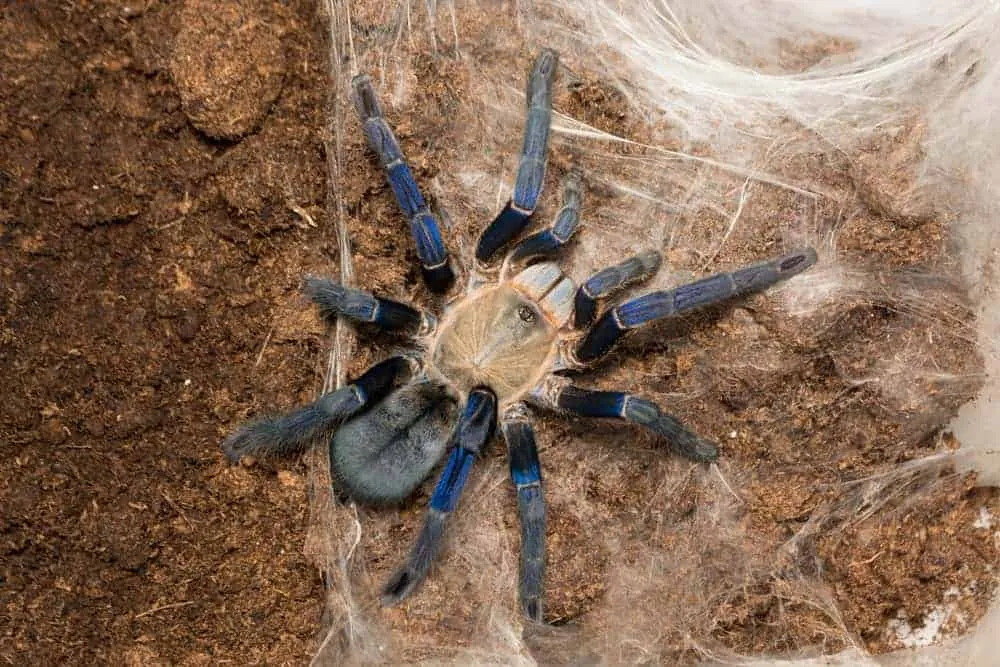
The unique coloration of the Cobalt Blue Tarantula is due to the presence of pigments and structural coloration in their exoskeleton. The blue color is not a pigment in the traditional sense, but rather a result of the way light interacts with the microscopic structures on the spider’s exoskeleton. These structures scatter light in a way that produces the characteristic blue hue. The intensity of the blue can vary with the spider’s age, molting cycle, and environmental factors. The younger spiderlings often have a less intense coloration compared to mature adults, and the vibrant color is at its peak shortly after a molt.
Size and Physical Characteristics
Cobalt Blue Tarantulas are medium-sized tarantulas. Females typically have a leg span of around 5–6 inches (12–15 cm), while males are slightly smaller. Apart from the striking coloration, these tarantulas have other physical features that are characteristic of their species. They possess eight legs covered in fine hairs, two chelicerae (fangs) used for injecting venom, and pedipalps that serve as sensory organs and are also used in mating. The abdomen is typically dark, often black or a very dark shade of blue. The spinnerets, located at the rear of the abdomen, are used to produce silk for constructing burrows and lining their habitats.
Habitat and Natural Environment
Understanding the natural habitat of the Cobalt Blue Tarantula is crucial for providing appropriate care in captivity. These tarantulas are native to the tropical rainforests of Myanmar (Burma), Thailand, and Vietnam. They prefer warm and humid environments, where they spend most of their lives in burrows. Their natural habitat is characterized by dense vegetation, high humidity, and moderate temperatures. They are predominantly terrestrial, spending their time on the ground or in burrows that they excavate or find beneath rocks, logs, or other debris. The availability of suitable shelter and a humid environment are key factors in their survival.
Origin and Geographic Location
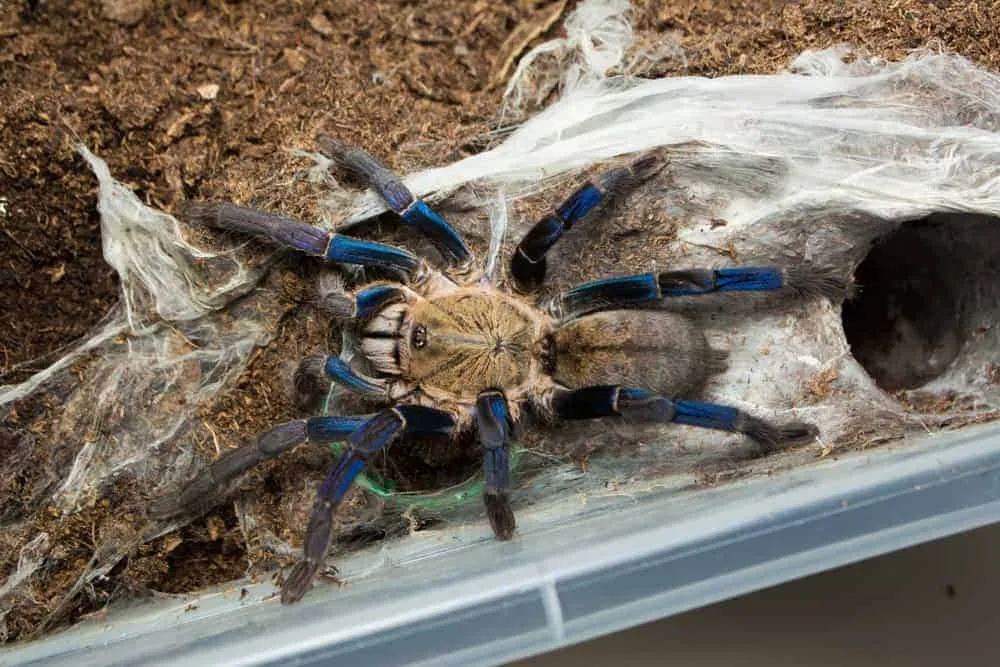
The Cobalt Blue Tarantula’s native range is concentrated in Southeast Asia. Specifically, they are found in the dense, humid rainforests of Myanmar, Thailand, and Vietnam. The specific microhabitats within these regions that they prefer typically feature rich soil, dense leaf litter, and access to moist areas. The availability of prey, such as insects and other invertebrates, is another key factor in determining their distribution. Due to habitat loss and the pet trade, wild populations face increasing pressure, making conservation efforts essential to their survival. Research into their exact distribution and population dynamics is ongoing.
Burrowing Behavior and Lifestyle
Cobalt Blue Tarantulas are fossorial, meaning they are burrowing spiders. In the wild, they excavate burrows in the soil or utilize existing shelters, such as crevices under rocks or logs. These burrows provide protection from predators, as well as a stable environment with consistent temperature and humidity. The spiders spend most of their time inside their burrows, venturing out primarily to hunt or mate. The burrow is also where they molt, a vulnerable process in which they shed their exoskeleton to grow. The depth and structure of the burrow can vary, but it typically includes a main chamber and connecting tunnels.
Temperament and Behavior
Cobalt Blue Tarantulas are known for their defensive nature and can be skittish. While not typically aggressive, they will readily defend themselves if they feel threatened. This defensive behavior can manifest in several ways, including raising their front legs in a threat posture, flicking urticating hairs (if present), or attempting to bite. Despite this, with careful handling and understanding their needs, they can be kept successfully as pets. However, beginners are often advised to start with less defensive species. Their temperament can vary between individuals, with some being more docile than others. It is important to approach them with caution and respect their space.
Defensive Mechanisms
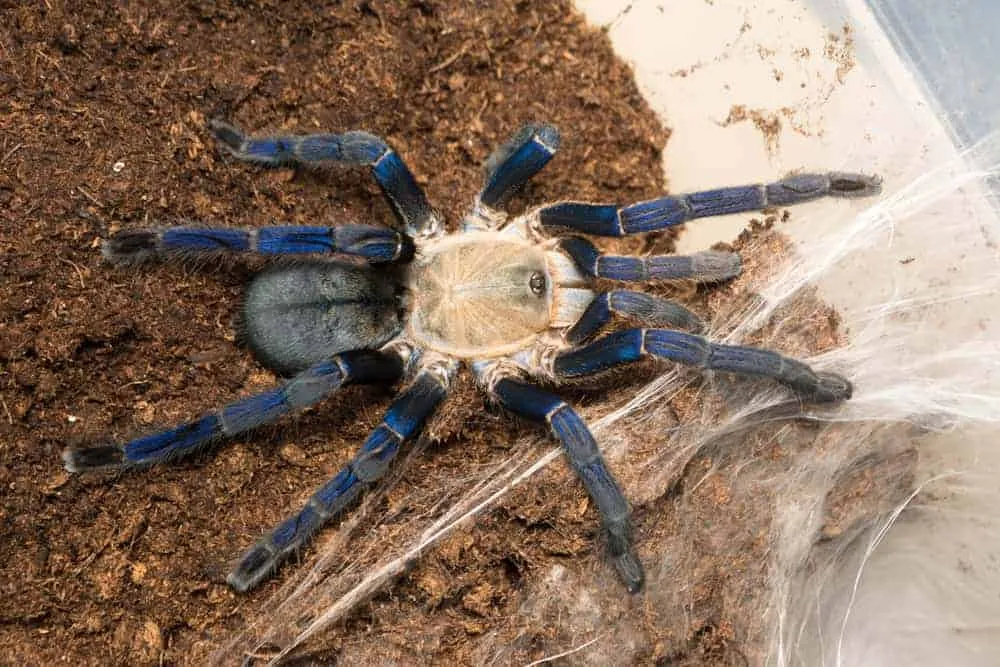
Cobalt Blue Tarantulas possess several defensive mechanisms to protect themselves from potential threats. Their primary defense is their bite, injecting venom to deter predators or subdue prey. They also exhibit a threat posture, where they rear up on their hind legs, raising their front legs and fangs, to appear larger and more intimidating. Although they do not possess urticating hairs, they may still employ other defensive tactics such as fleeing or kicking at perceived threats. Understanding these defensive mechanisms is essential for responsible ownership, as it helps to minimize the risk of bites and promotes safe handling practices.
Predatory Nature and Diet
As predators, Cobalt Blue Tarantulas primarily feed on insects and other invertebrates. In the wild, their diet consists of whatever prey is available, including crickets, grasshoppers, beetles, and occasionally small vertebrates. In captivity, they can be fed a variety of insects, such as crickets, mealworms, roaches, and other commercially available options. The size of the prey should be appropriate for the size of the tarantula, with juveniles requiring smaller meals more frequently, and adults needing larger, less frequent feedings. It is important to provide a varied diet to ensure the tarantula receives essential nutrients. Leftover prey should be removed to prevent stress and potential injury to the tarantula.
Cobalt Blue Tarantula as Pets
Keeping Cobalt Blue Tarantulas as pets can be a rewarding experience for those who are prepared to meet their specific needs. Their striking appearance and fascinating behavior make them a popular choice among tarantula enthusiasts. However, they are not recommended for beginners due to their skittish nature and specific habitat requirements. Responsible ownership involves providing a suitable habitat, maintaining appropriate temperature and humidity levels, and feeding them a balanced diet. Regular observation of their behavior and health is also crucial. With proper care, Cobalt Blue Tarantulas can live for many years in captivity, offering their keepers a unique window into the world of arachnids.
Responsible Ownership
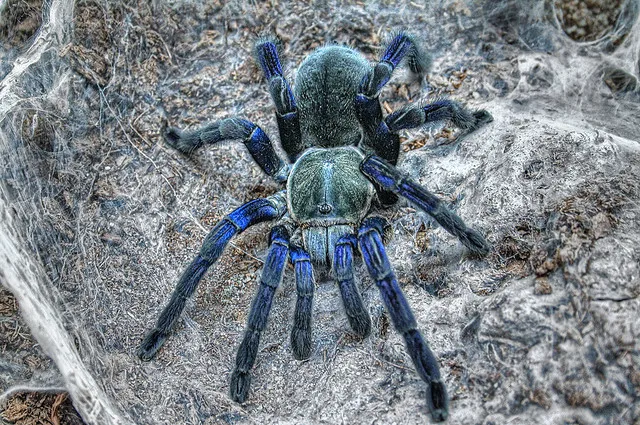
Responsible ownership of a Cobalt Blue Tarantula involves several key considerations. Researching their specific needs, including habitat, diet, and temperament, is essential before acquiring one. A proper enclosure, including appropriate substrate, hiding places, and water source is vital. Maintaining the correct temperature and humidity levels, using a reliable thermometer and hygrometer, is also critical. Regular feeding and monitoring the tarantula’s health are important aspects of responsible care. Handling should be kept to a minimum, as they are prone to defensive behaviors. Finally, it is important to source tarantulas from reputable breeders to ensure that they are healthy and ethically sourced, and to be aware of and comply with any local laws and regulations regarding the keeping of exotic animals.
Creating a Suitable Habitat
Creating a suitable habitat is crucial for the well-being of a Cobalt Blue Tarantula. The enclosure should be appropriately sized, providing enough space for the spider to move around and build a burrow. A glass terrarium or a plastic container with secure ventilation is ideal. The substrate should be deep enough to allow the tarantula to burrow, with a mix of peat moss, coconut fiber, and vermiculite being a good choice. A hide, such as a piece of cork bark or a half log, should be provided for shelter. The enclosure should be kept at a temperature between 75–85°F (24–29°C) with humidity levels between 70–80%. A shallow water dish should be provided for hydration, and the enclosure should be kept clean to prevent the build-up of mold and bacteria.
Feeding and Hydration
Proper feeding and hydration are vital for the health of your Cobalt Blue Tarantula. They should be fed a diet consisting primarily of insects, such as crickets, roaches, and mealworms. The size of the prey should be appropriate for the size of the tarantula; juveniles require smaller meals more frequently (every few days), while adults can be fed larger meals less often (once or twice a week). Ensure that the prey is gut-loaded (fed nutritious food) before offering it to the tarantula. A shallow water dish with clean water should always be available. Mist the enclosure regularly to maintain humidity levels, especially during molting, as adequate hydration is critical for this process.
Health and Common Issues
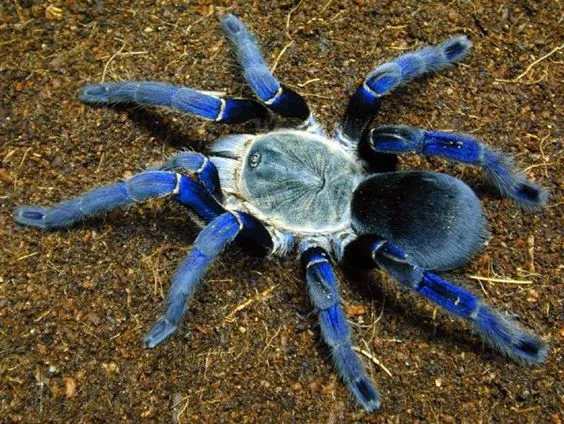
While generally hardy, Cobalt Blue Tarantulas can be susceptible to certain health issues. Parasites, such as mites, can sometimes infest the tarantula and its enclosure; these can be identified by tiny crawling organisms. Another common issue is dehydration, often caused by insufficient humidity or lack of access to water. Other potential problems include fungal infections and injuries from falls or bites from prey. Recognizing the signs of illness, such as lethargy, loss of appetite, or changes in behavior, is important. Regular observation of the tarantula and its enclosure is essential for early detection of any problems. Consult a veterinarian or experienced arachnid keeper if you notice any health concerns.
Molting and Growth
Molting is a natural process of growth for tarantulas, where they shed their exoskeleton to allow for expansion. The frequency of molting decreases as the tarantula ages; juveniles molt more often than adults. Prior to molting, the tarantula may become less active, refuse food, and may construct a web mat. During the molting process, the tarantula lies on its back, slowly wriggling out of its old exoskeleton. The entire process can take several hours or even days. Avoid disturbing the tarantula during molting, as it is a vulnerable time. After molting, the tarantula’s new exoskeleton is soft, and it should be given time to harden before being handled or fed. Provide a humid environment during this period to aid the process.
Handling and Safety
Handling Cobalt Blue Tarantulas should be approached with caution and respect. Their skittish nature and defensive behaviors mean that handling should be minimized. If handling is necessary, do so carefully and slowly, avoiding sudden movements. Approach the tarantula gently and allow it to walk onto your hand, rather than trying to pick it up. Always handle the tarantula over a soft surface, such as a bed or a carpet, in case it falls. Be mindful of the tarantula’s posture and body language; if it exhibits a threat posture, cease handling immediately. Wash your hands thoroughly before and after handling a tarantula, and be aware that the venom can cause localized symptoms in humans, such as pain, redness, and swelling.
Conservation Status and Threats
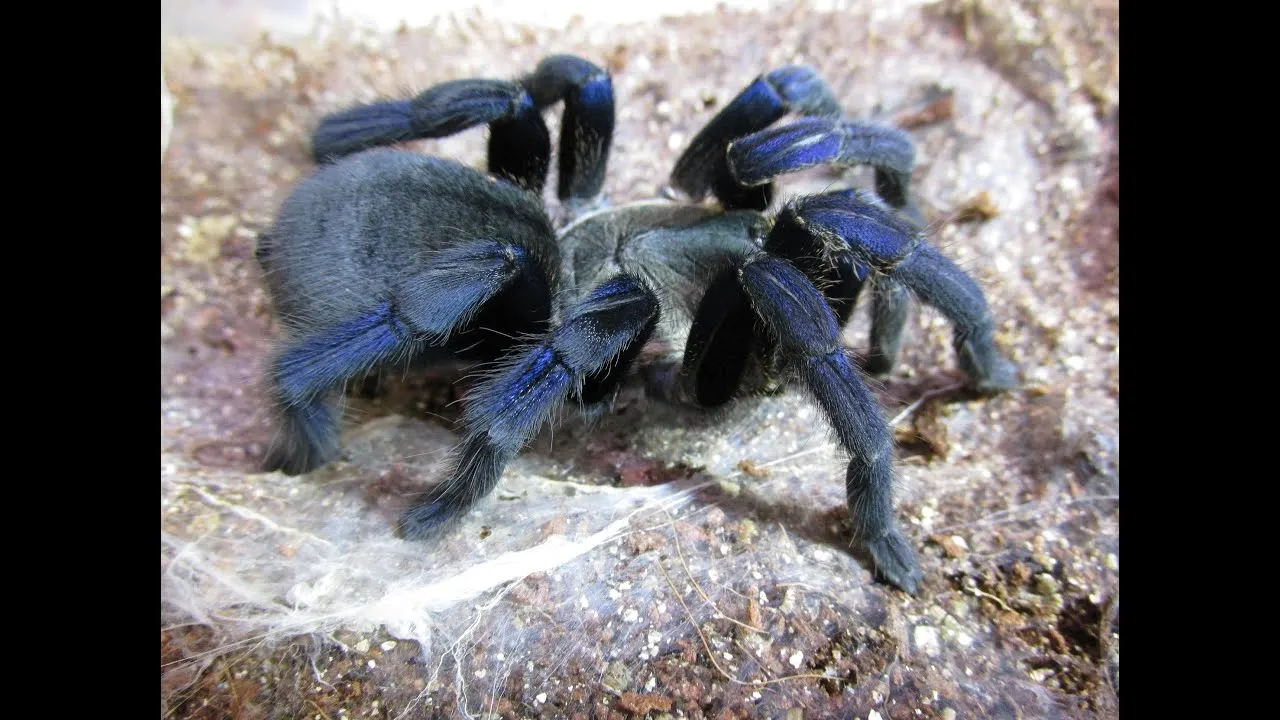
The Cobalt Blue Tarantula faces several threats in the wild, including habitat loss and the impact of the pet trade. Understanding these threats is crucial to supporting conservation efforts aimed at protecting the species. While not currently listed as endangered, ongoing monitoring and conservation measures are vital to ensure their long-term survival. Supporting reputable breeders, advocating for responsible pet ownership, and promoting habitat conservation are key ways to contribute to the preservation of this captivating species.
Threats in the Wild
The Cobalt Blue Tarantula faces a variety of threats in its natural environment. Habitat loss due to deforestation, agricultural expansion, and urbanization poses a significant risk, reducing the available space and resources for these tarantulas to thrive. The pet trade can also put pressure on wild populations, particularly if tarantulas are collected unsustainably. Other potential threats include climate change, which could alter their habitat and food sources, and the use of pesticides, which can negatively impact their prey base. Understanding these threats is crucial to developing effective conservation strategies.
Conservation Efforts
Various conservation efforts are underway to protect the Cobalt Blue Tarantula and its habitat. Supporting and promoting ethical breeding practices help to reduce the demand for wild-caught specimens. Habitat preservation and reforestation initiatives are also essential, aiming to protect and restore the tarantulas’ natural environment. Research into the species’ distribution, population dynamics, and threats is crucial for developing targeted conservation strategies. Raising awareness about the importance of tarantula conservation and encouraging responsible pet ownership among enthusiasts can help to protect these beautiful arachnids for future generations. Supporting organizations dedicated to tarantula conservation is another valuable contribution.
Conclusion
The Cobalt Blue Tarantula is a fascinating and visually stunning species that captures the imagination of many. While they can make rewarding pets for experienced keepers, understanding their specific needs and potential threats is vital. By providing a suitable habitat, practicing responsible ownership, and supporting conservation efforts, enthusiasts can contribute to the long-term survival of these beautiful arachnids. The vibrant colors, intriguing behavior, and overall uniqueness of the Cobalt Blue Tarantula make it an unforgettable species for those who appreciate the wonders of the natural world.
